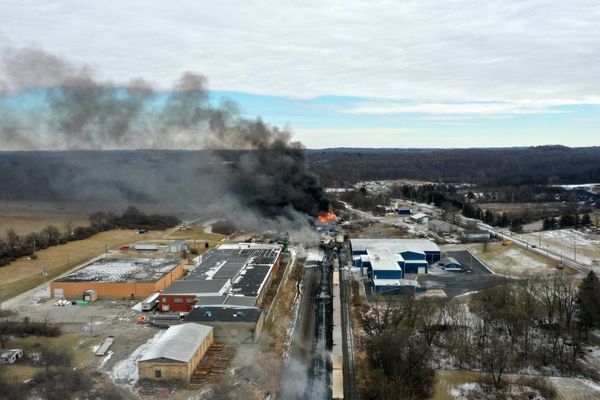
New Delhi, India – Gegong Jijong lined up with hundreds of other protesters on a cold afternoon last month near the Siang River in India’s northeastern state of Arunachal Pradesh, shouting antigovernment slogans.
“No dam over Ane Siang [Mother Siang],” the protesters in Parong village demanded.
The Siang River, cutting through serene hills, has been considered sacred for centuries by Jijong’s ancestors in the Adi tribal community – farmers whose livelihood depended on its water.
But all of that is now at risk, he said, as India moves to build its largest dam over their land.
The $13.2bn Siang Upper Multipurpose Project will have a reservoir that can hold nine billion cubic metres of water and generate 11,000 megawatts of electricity upon completion – more than any other Indian hydroelectric project. It was first proposed in 2017, and officials are now carrying out feasibility surveys.
Locals, however, warn that at least 20 villages will be submerged, and nearly two dozen more villages will partly drown, uprooting thousands of residents.
Amid intensifying resistance from locals, the Bharatiya Janata Party (BJP) -led state government has ordered the deployment of paramilitary forces to quell protests, though there have not been any clashes yet.
The protesters insist that they are not going anywhere. “The government is taking over my home, our Ane Siang, and converting it into an industry. We cannot let that happen,” said Jijong, the president of the Siang Indigenous Farmers’ Forum (SIFF) community initiative. “Till the time I’m alive and breathing, we will not let the government construct this dam.”
But the BJP government argues that the protesters have got it wrong. Arunachal Pradesh Chief Minister Pema Khandu has insisted that it is “not just a hydro dam,” but that its “real objective is to save the Siang River”.
From China.
A fragile ecosystem
At the heart of the Indian dam project that Jijong and his community are opposing is a geostrategic contest for water and security between New Delhi and Beijing, who are locked in a tense rivalry that, in recent years, has also at times exploded into deadly border clashes.
The Siang River originates near Mount Kailash in Tibet, where it is known as the Yarlung Zangbo. It then enters Arunachal Pradesh and becomes much wider. Known as the Brahmaputra in most of India, it then flows into Bangladesh before sinking into the Bay of Bengal.
Last month, China approved the construction of its most ambitious – and the world’s largest – dam over the Yarlung Zangbo, in Tibet’s Medog county, right before it enters Indian territory.

Soon after China first officially announced its plan to construct the dam in 2020, officials in New Delhi started seriously considering a counter-dam to “mitigate the adverse impact of the Chinese dam projects”. The Indian government argues that the Siang dam’s large reservoir would offset the disruption in the flow of the river by the upcoming Medog dam, and safeguard against flash floods or water scarcity.
But the presence of two giant dams in a Himalayan region with a fragile ecosystem and a history of devastating floods and earthquakes poses serious threats to millions of people who live there and further downstream, caution experts and climate activists. And India and China’s dangerous power tussle over Himalayan water resources could disproportionately hurt Indigenous communities.
‘Major flashpoint’
The new mega-dam in Medog county over the Yarlung Zangbo will dwarf even the Three Gorges Dam, currently the world’s largest hydro dam, in central China. Beijing says that the project will be vital in meeting its net-zero emissions goal by 2060, and Chinese news agencies reported that the dam will cost $137bn. There is no immediate clarity on how many people will be displaced on the Chinese side.
The dam’s construction, at the Great Bend near Mount Namcha Barwa, will also be an engineering marvel of sorts. As the water falls into one of the deepest gorges in the world – with a depth exceeding 5,000 metres (16,400 feet) – it will generate about 300 billion kilowatt-hours of electricity annually.
The massive new project is the latest in a series of dams – the previous ones were smaller – that China has built on the Yarlung Zangbo and its tributaries, said BR Deepak, professor of Chinese studies at the Jawaharlal Nehru University (JNU), New Delhi.
And these dams “should be considered as one of the major flashpoints between India and China,” he said, citing how “some of the biggest conflicts have originated out of the trans-water rivers”. The water of the tributaries of the Indus River is a major bone of contention between India and Pakistan. Ethiopia and Egypt, meanwhile, are locked in a dispute over a giant dam that Ethiopia is building on the Nile.
But India’s response, by constructing a dam over the Siang River, “adds fuel to the fire,” said Deepak. “Till China keeps damming these rivers, fears and anxieties will continue and stoke strong responses from lower riparian countries.”
A report by the Lowy Institute, an Australian think tank, in 2020 argued that control over rivers originating in the Tibetan Plateau essentially gives China a “chokehold” over India’s economy.
The ‘chokehold’
Throughout history, the Yarlung Zangbo was often known in China as the “river gone rogue”: Unlike other major Chinese rivers that flow west to east, it turns sharply south at the Great Bend to enter India.
Beijing’s decision to choose this strategic location for the dam, next to the border with India, has prompted concerns in New Delhi.
“It is obvious that China will have the card to use the dam as a strategic factor in its relationship with India to manipulate water flows,” said Saheli Chattaraj, assistant professor of Chinese studies at Jamia Millia Islamia University in New Delhi.
Deepak agreed. “Lower riparian like Bangladesh and India will always fear that China may weaponise water, especially in the event of hostilities, because of the dam’s large reservoir.” The reservoir is projected to have the capacity to hold 40 billion cubic metres of water.
The fragility of the terrain adds to worries. “The damming of the river is fraught with several dangers,” said Deepak. About 15 percent of the great earthquakes – with a magnitude greater than 8.0 on the Richter Scale – in the 20th century occurred in the Himalayas.
And that pattern of major earthquakes hitting Tibet has continued. On January 7, a 7.1-scale earthquake killed at least 126 people. At least five out of 14 hydro dams in the region examined by Chinese authorities after the earthquake had ominous signs of damage. The walls of one were tilting, while some others had cracks. Three dams were emptied, and several villages were evacuated.
Meanwhile, the Indian government has told anti-dam protesters in Arunachal Pradesh that a counter-dam is needed to mitigate the risks of China flooding their lands, punctuating its warnings with terms like “water bomb” and “water wars”.
Chattaja, the assistant professor, pointed out that neither India nor China are signatories to the UN’s international watercourses convention that regulates shared freshwater resources, like the Brahmaputra.
India and China have been parties to a memorandum of understanding since 2002 for the sharing of hydrological data and information on the Brahmaputra during flood seasons. But after a military standoff in Doklam – near their shared border with Bhutan – between the nuclear-armed neighbours in 2017, India said that Beijing had temporarily stopped sharing hydrological data. That spring, a wave of floods hit the northeastern Indian state of Assam, leading to more than 70 deaths and displacing more than 400,000 people.
“It is a problematic scenario and, moreover, when the relationship deteriorates or it is malevolent, like the way it was in 2017, China immediately stopped sharing the data,” said Deepak.
Sour neighbours, bitter relations
The Medog county dam was part of China’s 14th Five-Year Plan (2021-2025), and planning has been under way for more than a decade. However, it was officially announced on December 25, triggering sharp responses from India.
Randhir Jaiswal, spokesperson for India’s Ministry of External Affairs, said that New Delhi has “established user rights to the waters of the river”, and has “consistently expressed our concerns to the Chinese side over mega projects on rivers in their territory”.
He added that New Delhi has urged Beijing “to ensure that the interests of downstream states of the Brahmaputra are not harmed by activities in upstream areas”, adding that India will “continue to monitor and take necessary measures to protect our interests”.
Two days later, spokesperson for the Chinese Ministry of Foreign Affairs, Mao Ning, told reporters that the project “will not negatively affect the lower reaches”, and Beijing will “continue to maintain communication with [lower riparian] countries through existing channels and step up cooperation on disaster prevention”. She again underscored the Medog county dam’s role in China’s pivot towards clean energy and other hydrological disasters.
Yet, trust between India and China is in short supply.
Last October, the countries reached an agreement to disengage after nearly five years of a tense military standoff in Ladakh, following a deadly military clash on the disputed border in 2020.
But the agreement must not be mistaken for an ice break in sour relations, warned Michael Kugelman, South Asia Institute director at the Wilson Center, a Washington, DC-based think tank. “There are simply too many points of divergence and tension between India and China, including this latest flashpoint around water, to expect that we could see strength in relations,” he told Al Jazeera.
Kugelman pointed out that both India and China have borne the adverse effects of climate change, including water shortages, and their tussle over water will likely only intensify in the coming years.
“India just cannot afford to see water, which it expects to flow down, be bottled up in China,” he said.
‘Bangladesh will face most adverse impact’
But while India and China engage in a tug-of-war, experts say that the worst impact could be felt by millions of people in Bangladesh.
Although only 8 percent of the 580,000-square-kilometre (224,000-square-mile) area of the Brahmaputra basin falls in Bangladesh, the river system annually provides over 65 percent of the country’s water. That’s why it is viewed as the “lifeline of Bangladesh”, said Sheikh Rokon, secretary-general of Riverine People, a Dhaka-based civil society organisation that focuses on water resources.
“The ‘dam for a dam’ race between China and India will impact us most adversely,” Rokon told Al Jazeera.
Those fears have kept Malik Fida Khan, executive director at the Dhaka-based Center for Environmental and Geographic Information Services (CEGIS), on edge for a decade now.
“We have access to no information. Not a feasibility report, or the details of the technology that will be used,” he said, his tone tense. “We need a shared, and detailed, feasibility study, environmental impact assessment, and then social and disaster impact assessment. But we have had nothing.”
The Brahmaputra also forms one of the world’s largest sediment deltas in Bangladesh, before entering the Bay of Bengal, and directly supports millions who live on its banks. “If there is any imbalance in the sediment flow, it will increase the riverbank erosion and any chances of potential land reclaiming will vanish,” Khan said.
India’s dam, Khan lamented, could be particularly damaging to the part of the basin in Bangladesh. “You cannot counter a dam with another down,” he said. “It will have a huge and fatal impact on millions of us living downstream.”
Rokon agreed. “We need to get out of the ‘wait and see’ attitude regarding Chinese or Indian dams,” he said, reflecting upon the Bangladesh government’s current policy. “The discussion on the Brahmaputra river should not be a mere bilateral discussion between Bangladesh and India, or India and China; it should be a basin-wide discussion.”
Since the ouster of Bangladeshi Prime Minister Sheikh Hasina from Dhaka, whose government was backed by New Delhi, the new dispensation led by Nobel laureate Muhammad Yunus has maintained its distance from India. This also means that there is no joint effort, or a unified pushback, from the South Asian countries to counter China’s growing command over the Brahmaputra river, say analysts.
Whereas Khan sees this water crisis as “a golden opportunity” for India and Bangladesh to forge ties, Kugelman of Wilson Center isn’t optimistic.
“We’ve seen that China is not a country that is receptive to external pressure, whether it be from one country, or two, or even 10,” said Kugelman. “Even if India and Bangladesh were in a position to muster joint resistance toward these Chinese moves, it would not be sufficient to deter Beijing’s actions.”
Meanwhile, the threat facing communities on the front lines of these water tensions is only going to grow, say experts.
“One cannot emphasise enough on the significance and seriousness of these water tensions because of how climate change effects could make these tensions much more dangerous and potentially destabilising in the upcoming decade,” Kugelman told Al Jazeera.
Back in Parong village near the Siang River, Jijong says he has no time to rest. “We have been making more and more people aware about the implications of these dams,” he said.
“I do not know about the next generation, but, even if I am 90 years old and cannot walk,” said Jijojng, pausing for a long breath, “I will continue to resist.”







